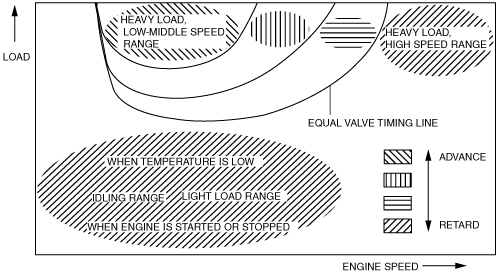VARIABLE VALVE TIMING MECHANISM FUNCTION [MZR 1.6]
id0110f6101000
• The variable valve timing mechanism continuously modifies the phases of the variable valve timing actuator and the intake camshaft using hydraulic pressure controlled by the oil control valve (OCV) so that optimal valve timing is obtained according to engine operation conditions.
• OCV operation is based on signals from the PCM according to engine operation conditions and it controls hydraulic pressure to the variable valve timing actuator.
Operation and purpose according to driving condition
Idling range, light load range
• Due to a reduction in the amount of overlap, less combusted gas is returned to the intake port. This stabilizes idle speed in the idling range, improving fuel economy, and also ensures engine stability in the light load range.
When engine is started or stopped
• Start ability has been improved because the overlap amount has been minimized to prevent combusted gas from returning to the intake port.
When temperature is low
• The overlap amount has been minimized to prevent combusted gas from returning to the intake port and to reduce the additional fuel injection amount. This improves fuel economy and stabilizes fast idle speed.
Heavy load, low-middle speed range
• Low to mid-speed torque has been improved by increasing the speed of the intake air valve closing-time to improve the volumetric efficiency of the intake valve at the point where intake air volume is at its highest.
Heavy load, high speed range
• Maximum output has been improved by slowing the close-timing of the intake air valve to improve volumetric efficiency of the valve by slowing the air intake in relation to piston speed.
